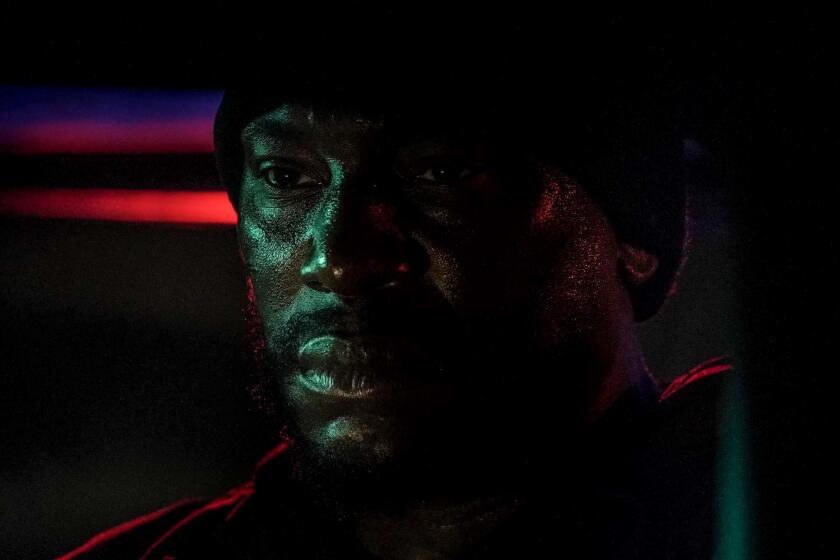Perhaps Shakespeare’s Muse Inspired Movie That Delights
“Shakespeare in Love” was the Christmas present no one expected.
Everywhere I go, I hear people recommending the Miramax romantic comedy for its charm and its playful intelligence.
Part of the movie’s appeal may be simply what it isn’t--a numbing succession of car crashes, calculated to mesmerize boys of all ages. As a result, people are reacting to “Shakespeare in Love” the way they do to a good book: They want to share it with people they care about. I told my ex-husband not to miss it.
“I personally found it delightful,” says Lisa Rado, who teaches English at Studio City’s Harvard-Westlake School.
Like others all over the Valley, Rado couldn’t get in on her first attempt to see the witty, romantic tale of how Shakespeare came to write “Romeo and Juliet.” It was sold out.
“We tried to see it about a week ago, and we had to make reservations in advance,” recalls Rado, who teaches modernist literature at the prestigious private school.
A great date movie, “Shakespeare in Love” is also the kind of sophisticated entertainment students love recommending to their teachers.
“You absolutely have to see this film,” her students had been telling Rado about the movie that purports to explain why Shakespeare’s tragic love story isn’t called “Romeo and Ethel, the Pirate’s Daughter.”
With a doctorate in English literature from the University of Michigan, Rado is one of the minority of moviegoers who gets the jokes about John Webster.
In the film, directed by John Madden, Webster is a sadistic teenager who hangs around theaters, doing unspeakable things to small animals. In real life, he was the 17th century author of such gory, but lyrical, plays as “The Duchess of Malfi” and “The White Devil.”
Rado’s students read “Romeo and Juliet” in middle school, and they are also familiar with the work of Tom Stoppard, the word-drunk playwright who coauthored the screenplay with Marc Norman.
Stoppard’s 1967 play “Rosencrantz and Guildenstern Are Dead,” which retells “Hamlet” from the point of view of two minor characters, is “a mainstay of the 12th-grade curriculum” at Harvard-Westlake, Rado says.
Rado was struck by the filmmakers’ ability to weave together multiple narratives. She also appreciated the film’s metafictional quality--its ability to reveal so much about the nature of fiction.
And it’s no surprise to her that teenagers are responding to the film’s re-creation of not one, but two, passionate love stories. They are teenagers, after all, and that’s what they’re thinking about--when they are not praying that Brown or Stanford will accept them.
Nichols Canyon resident Jacqueline Green and her fiance, Henry Bloomstein, also loved the film. Green has a Beverly Hills public relations firm and Bloomstein is a writer/producer.
Like others who work in or with the entertainment industry, they laughed at the inside jokes--including a boatman who pitches a play to young Shakespeare as he rows the lovesick playwright across the Thames and a theater producer who describes himself as “the money.”
The film is so full of word play and clever allusions, says Green, “We want to see it again. Henry’s got a screening at the Writers Guild in a couple of weeks.”
Harold Bloom, one of the nation’s leading Shakespeare scholars who has professorships at both Yale and New York University, places Shakespeare at the very heart of the Western canon. Bloom has written more than 20 books, including “The Western Canon,” “The Book of J” and the recently published “Shakespeare: The Invention of the Human.”
At home in New Haven, Conn., Bloom said he had not yet seen “Shakespeare in Love,” in which a glowing Gwyneth Paltrow plays Romeo, Juliet and Viola De Lesseps, the fictional noblewoman who becomes Shakespeare’s muse. “My wife tells me I will enjoy it,” said Bloom, who will definitely get the John Webster jokes.
Instead of the new movie, we talked about the eternally popular play that inspired it--”Romeo and Juliet.”
In Bloom’s view, the primary reasons for the play’s “perpetual appeal” are the power of the theme of star-crossed lovers and Shakespeare’s remarkable achievement in limning Juliet.
Bloom praised Shakespeare’s “radiant success in giving us a Juliet who is so infinitely generous. She’s a child, but she’s emotionally mature--as mature as anyone you can find in Western literature. She’s Shakespeare’s miracle.”
We talked about how each generation seems to discover the love story for itself. Young people flocked to the Franco Zeffirelli film version in 1968, just as they did to the 1996 Baz Luhrmann version that starred Claire Danes and Leonardo DiCaprio. Bloom recalled the 1936 George Cukor version in which John Barrymore, as Mercutio, outshone Norma Shearer’s Juliet and Leslie Howard’s Romeo. “It’s one of the Shakespearean plays that defines a generation,” Bloom said.
“The play is undoubtedly Shakespeare at his most erotically idealistic. The Shakespeare who wrote ‘Romeo and Juliet’ undoubtedly still believes in romantic love,” Bloom said, noting that that can’t necessarily be said of the author’s later plays.
“It’s infinitely touching,” Bloom said. “She’s infinitely touching. There are grander women in Shakespeare,” Bloom said, citing Cleopatra. “But not even Desdemona overmatches Juliet as an infinitely good woman in love.”
More to Read
Only good movies
Get the Indie Focus newsletter, Mark Olsen's weekly guide to the world of cinema.
You may occasionally receive promotional content from the Los Angeles Times.








